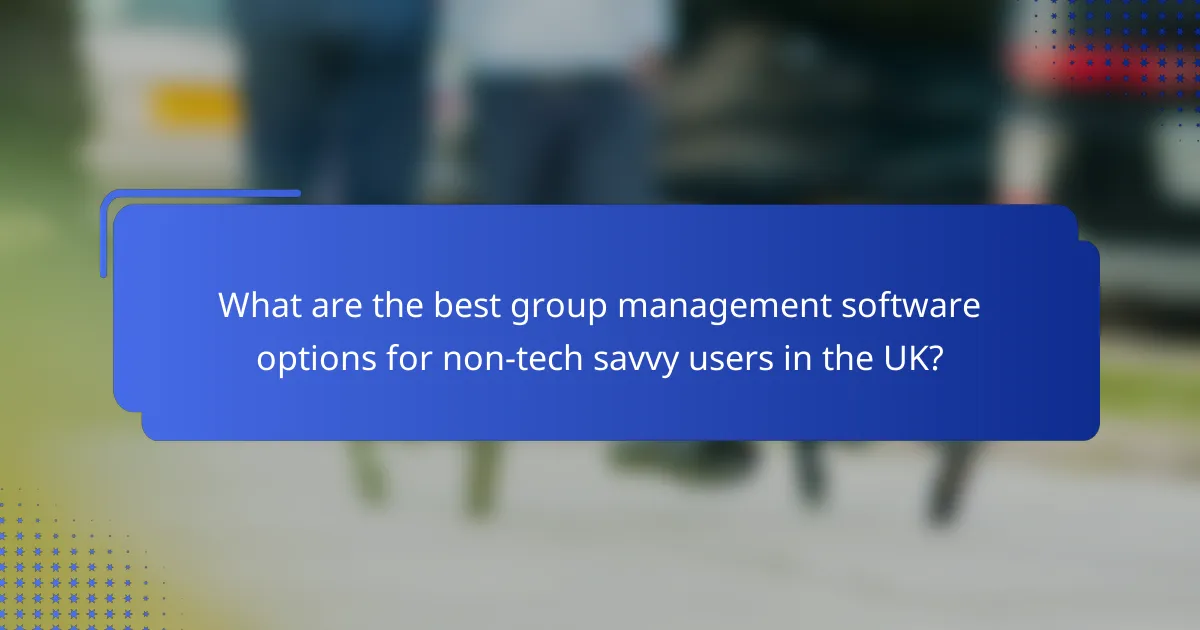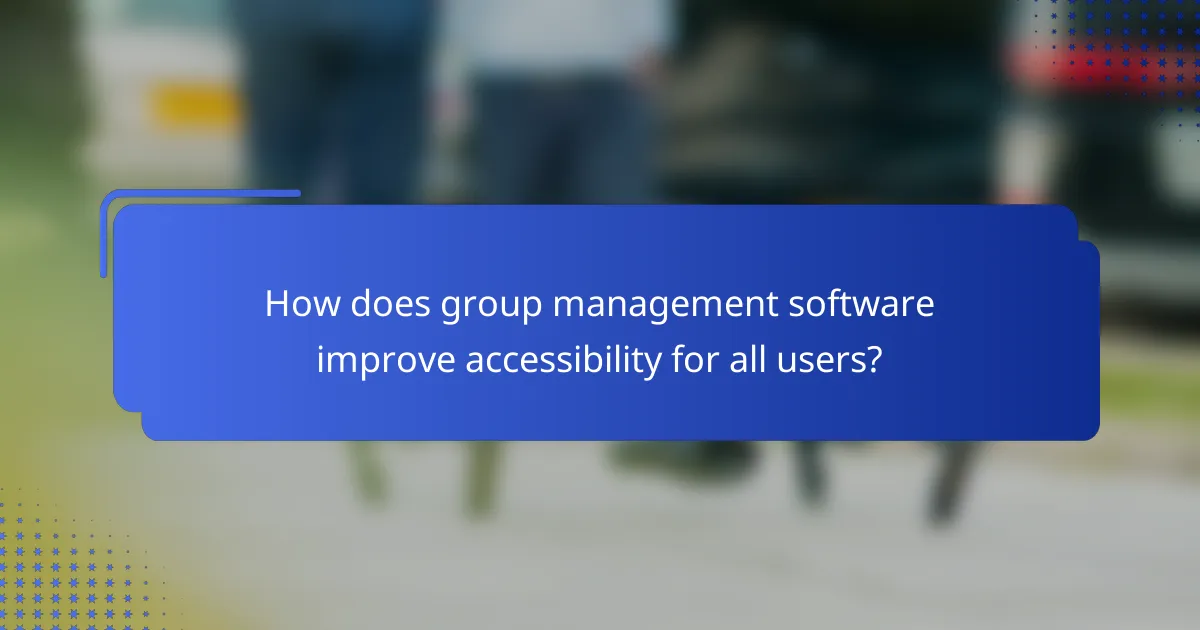Group management software is essential for fostering collaboration and organization, especially for non-tech savvy users. By prioritizing simplicity and intuitive design, tools like Monday.com, Asana, and Trello ensure that everyone can participate effectively, regardless of their technical skills. These platforms enhance accessibility through user-friendly interfaces and compatibility with various devices, breaking down barriers for all users.

What are the best group management software options for non-tech savvy users in the UK?
For non-tech savvy users in the UK, the best group management software options are those that prioritize simplicity and intuitive design. Tools like Monday.com, Asana, Trello, Basecamp, and Wrike offer user-friendly interfaces that make collaboration straightforward, even for those with limited technical skills.
Monday.com
Monday.com is known for its visually appealing interface and customizable workflows, making it easy for non-tech savvy users to manage projects. Users can create boards to track tasks, deadlines, and team assignments with simple drag-and-drop functionality.
To get started, users can choose from various templates tailored to different industries, which can significantly reduce setup time. It’s advisable to take advantage of the platform’s tutorials and customer support to maximize its features.
Asana
Asana offers a clean and organized layout that helps users focus on their tasks without feeling overwhelmed. It allows teams to create projects, assign tasks, and set deadlines in a straightforward manner.
Non-tech savvy users can benefit from Asana’s task dependencies feature, which visually indicates the order of tasks. Utilizing the mobile app can also enhance accessibility, allowing users to manage their work on the go.
Trello
Trello uses a card-based system that is highly intuitive for users unfamiliar with technology. Each project is represented by a board, and tasks are organized as cards that can be moved between different lists, making it easy to visualize progress.
For beginners, Trello’s simplicity is a major advantage. Users can start with basic boards and gradually explore advanced features like automation as they become more comfortable with the platform.
Basecamp
Basecamp is designed for simplicity and ease of use, making it ideal for teams with non-tech savvy members. It centralizes communication, task management, and file sharing in one platform, reducing the need for multiple tools.
Users can create to-do lists, set deadlines, and communicate through message boards, all in a user-friendly environment. Basecamp’s flat pricing model can also be appealing, as it allows unlimited users for a single monthly fee.
Wrike
Wrike combines powerful project management features with a user-friendly interface, making it accessible for non-tech savvy users. It offers customizable dashboards and reporting tools that help teams track their progress effectively.
New users should focus on the basic features first, such as task creation and assignment, before exploring more complex functionalities. Wrike also provides training resources that can help users get up to speed quickly.

How does group management software improve accessibility for all users?
Group management software enhances accessibility by providing features that cater to diverse user needs, ensuring everyone can participate effectively. By focusing on user-friendly design and compatibility with various devices, these tools break down barriers for non-tech-savvy individuals.
Mobile compatibility
Mobile compatibility allows users to access group management software from smartphones and tablets, making it easier for those who may not have regular access to a computer. This flexibility is crucial for users who are on the go or prefer using mobile devices for their tasks.
Many group management platforms offer responsive designs that adjust to different screen sizes, ensuring a seamless experience. Users can manage tasks, communicate, and collaborate from anywhere, which significantly enhances overall accessibility.
Customizable interfaces
Customizable interfaces enable users to tailor the software to their preferences, improving usability for individuals with varying levels of technical expertise. Users can often adjust layouts, colors, and font sizes to create a more comfortable working environment.
This personalization helps reduce cognitive load, allowing users to focus on their tasks without being overwhelmed by unnecessary features. For instance, a user might simplify their dashboard to display only the tools they frequently use, making navigation more intuitive.
Assistive technology integration
Integrating assistive technology, such as screen readers and voice recognition software, further enhances accessibility for users with disabilities. Group management software that supports these tools ensures that all users can engage with the platform effectively.
For example, platforms that comply with Web Content Accessibility Guidelines (WCAG) allow users with visual impairments to navigate and utilize features through auditory feedback. This integration not only broadens user participation but also aligns with best practices for inclusivity in digital environments.

What features enhance ease of use in group management software?
Group management software is designed to simplify collaboration and organization, making it accessible even for non-tech-savvy users. Key features that enhance ease of use include intuitive interfaces, straightforward navigation, and tools that require minimal technical knowledge.
User-friendly dashboards
User-friendly dashboards provide a clear overview of tasks, projects, and team activities, allowing users to quickly assess their workload. These dashboards often use visual elements like graphs and charts to represent data, making it easier for users to understand progress at a glance.
When selecting software, look for customizable dashboards that allow users to prioritize information relevant to their roles. This personalization can significantly improve efficiency and engagement among team members.
Drag-and-drop functionality
Drag-and-drop functionality simplifies the process of organizing tasks and resources within group management software. Users can easily move items like files, tasks, or calendar events with a simple click and drag, reducing the complexity of managing projects.
This feature is particularly beneficial for non-tech-savvy users, as it minimizes the need for extensive training. Ensure that the software you choose has this capability to enhance user experience and streamline workflows.
Template availability
Template availability allows users to start projects quickly without having to create everything from scratch. Many group management tools offer pre-designed templates for various tasks, such as project planning, meeting agendas, and reports.
Utilizing templates can save time and help maintain consistency across projects. When evaluating software, check for a variety of templates that cater to different needs and industries, ensuring they align with your team’s objectives.

What are the key criteria for selecting group management software?
When selecting group management software, focus on integration capabilities, pricing structures, and user support options. These criteria ensure that the software meets your group’s specific needs while remaining accessible to all users, including those who may not be tech-savvy.
Integration capabilities
Integration capabilities refer to how well the software connects with other tools and platforms your group already uses. Look for software that can seamlessly integrate with popular applications like calendars, email services, and project management tools to streamline workflows.
Consider whether the software offers APIs or pre-built integrations, as these can greatly enhance functionality. For example, if your team relies on Google Workspace, ensure the software can sync with Google Drive and Calendar for efficient collaboration.
Pricing structures
Pricing structures can vary significantly among group management software options, so it’s essential to evaluate what fits your budget. Many platforms offer tiered pricing based on features, number of users, or storage capacity, typically ranging from a few dollars to several hundred per month.
Be mindful of hidden costs, such as additional fees for premium features or support. Some software may provide a free trial or a freemium model, allowing you to test the service before committing financially.
User support options
User support options are crucial for ensuring that all members of your group can effectively use the software, especially those who are not tech-savvy. Look for platforms that offer multiple support channels, such as live chat, email, and phone support.
Additionally, consider the availability of training resources like tutorials, webinars, and community forums. A robust support system can significantly reduce the learning curve and enhance overall user satisfaction.

How can group management software facilitate collaboration among diverse teams?
Group management software enhances collaboration by providing tools that streamline communication and project management among team members with varying skill levels. These platforms offer user-friendly interfaces and features that cater to both tech-savvy and non-tech-savvy users, ensuring everyone can contribute effectively.
Real-time updates
Real-time updates allow team members to stay informed about project progress and changes as they happen. This feature minimizes delays and miscommunication, as everyone can see the latest information without needing to refresh or check in manually.
For example, when a team member updates a task status, all users receive immediate notifications, ensuring that everyone is aligned. This is particularly beneficial for teams working across different time zones, as it keeps all members engaged and aware of developments at all times.
Task assignment features
Task assignment features enable managers to allocate responsibilities clearly and efficiently. Users can create tasks, assign them to specific team members, and set deadlines, which helps in organizing workflows and ensuring accountability.
Many platforms also allow for priority settings, enabling teams to focus on critical tasks first. This structured approach can significantly enhance productivity, especially in diverse teams where roles and responsibilities may vary widely.
File sharing capabilities
File sharing capabilities are essential for collaboration, allowing team members to upload, access, and edit documents in a centralized location. This eliminates the need for cumbersome email exchanges and ensures that everyone is working with the most current version of a file.
Most group management software supports various file types and integrates with cloud storage services, making it easy to share large files securely. Additionally, features like version control help track changes, reducing the risk of errors and confusion among team members.

What are the common challenges faced by non-tech savvy users?
Non-tech savvy users often struggle with complex interfaces, unfamiliar terminology, and a lack of intuitive guidance in group management software. These challenges can lead to frustration and decreased productivity, making it essential for software to prioritize user-friendliness and accessibility.
Complex Interfaces
Many group management software solutions feature complex interfaces that can overwhelm users who are not familiar with technology. These interfaces often include numerous buttons, menus, and settings that can be confusing. Simplifying the layout and minimizing clutter can significantly enhance usability for these users.
To address this, software developers should consider implementing a clean, streamlined design that focuses on essential features. Providing a customizable dashboard can also help users prioritize the tools they need most, reducing the learning curve.
Unfamiliar Terminology
Non-tech savvy users may encounter jargon or technical terms that are not easily understood. This can create barriers to effective use of the software, as users may not know what certain features do or how to access them. Using plain language and clear labels can make a significant difference.
Offering tooltips or help icons that explain terms in simple language can further aid comprehension. Additionally, providing a glossary of terms within the software can empower users to familiarize themselves with the necessary vocabulary.
Lack of Intuitive Guidance
Without intuitive guidance, non-tech savvy users may feel lost when navigating group management software. A lack of tutorials or onboarding processes can lead to frustration and abandonment of the tool. Implementing guided tours or step-by-step walkthroughs can enhance user experience.
Consider incorporating video tutorials or interactive demos that users can access at their own pace. Regular updates and feedback mechanisms can also help ensure that the software evolves to meet user needs effectively.
